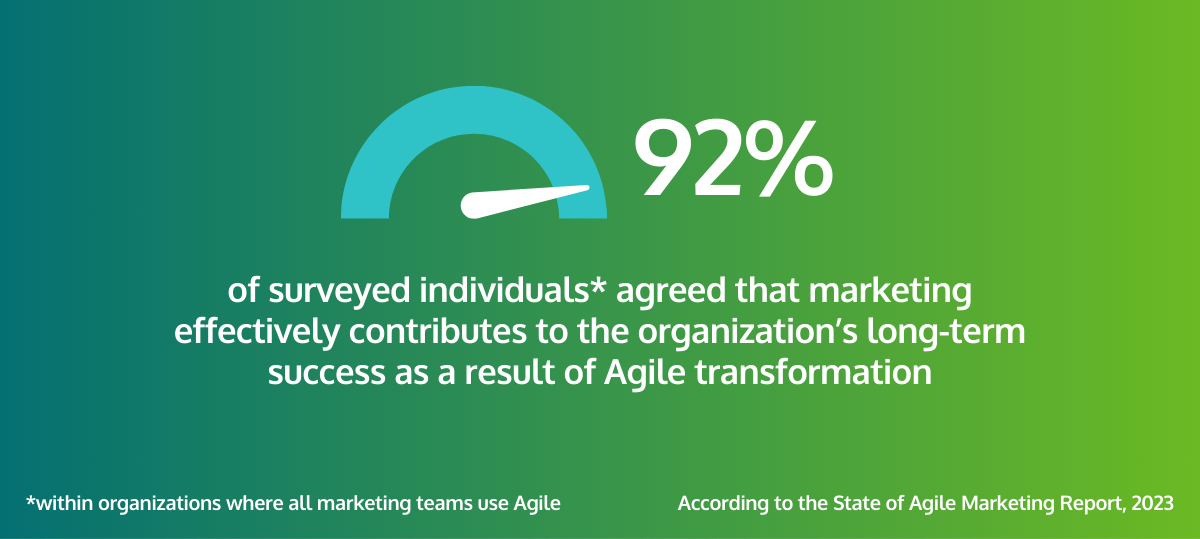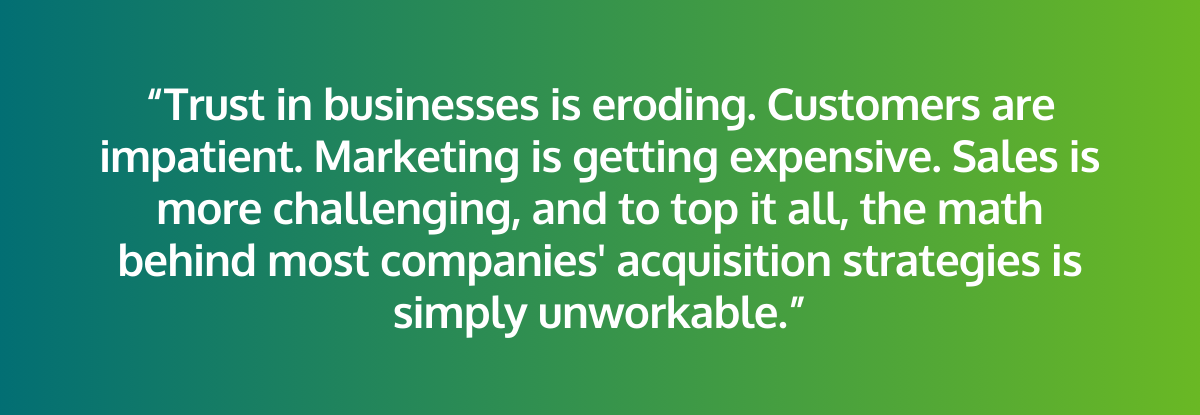-
- marketing agility
- Teams
- Organizations
- Education
- enterprise
- Articles
- Individuals
- Transformation
- Solution
- Leadership
- Getting Started
- business agility
- agile management
- going agile
- Frameworks
- agile mindset
- Agile Marketing Tools
- agile marketing journey
- organizational alignment
- Agile Marketers
- People
- Selection
- (Featured Posts)
- strategy
- agile journey
- Metrics and Data
- Kanban
- Resources
- Why Agile Marketing
- agile project management
- self-managing team
- Meetings
- Scrum
- agile adoption
- scaled agile marketing
- tactics
- scaled agile
- AI
- Agile Meetings
- agile marketing training
- agile takeaways
- Agile Leadership
- agile coach
- enterprise marketing agility
- Scrumban
- state of agile marketing
- team empowerment
- Intermediate
- agile marketing mindset
- agile marketing planning
- agile plan
- Individual
- Team
- Videos
- agile marketing
- kanban board
- Agile Marketing Terms
- agile transformation
- traditional marketing
- FAQ
- agile teams
- Agile Marketing Glossary
- CoE
- Scrumban
- agile
- agile marketer
- agile marketing case study
- agile marketing coaching
- agile marketing leaders
- agile marketing methodologies
- agile marketing metrics
- agile pilot
- agile sales
- agile team
- agile work breakdown
- cycle time
- employee satisfaction
- marketing value stream
- marketing-analytics
- remote teams
- sprints
- throughput
- work breakdown structure
- News
- agile brand
- agile marketing books
- agile marketing pilot
- agile marketing transformation
- agile review process
- agile team charter
- cost of delay
- hybrid framework
- pdca
- remote working
- scrum master
- stable agile teams
- stand ups
- startups
- team charter
- team morale
- user story
- value stream mapping
- visual workflow

It’s a new year and, like every year, that means a brand new set of marketing challenges we all need to overcome.
Sure, managers will be dealing with a lot of the same marketing challenges as 2023, but with the speed marketing is evolving these days, we all know new issues are inevitable.
So instead of waiting for these challenges to come your way, you can start 2024 off by learning how to tackle them head on.
1. Improving ROI
This first marketing challenge here is hardly new. But there’s no denying that senior leaders are putting more pressure on marketing managers to demonstrate ROI than ever. That’s unsurprising considering how marketing budgets are shrinking across the board.
The problems start with the way many marketing managers tackle improving ROI: working harder. The real solution boils down to a focus on working smarter.

In practice, that means rigorously focusing on marketing operations: better prioritization, retrospectives, and generally improving the processes behind your work. The reasoning is simple: relying on the hottest new marketing trend to give you the ROI you need might work, but it’s always going to be a gamble.
Investing in processes, by contrast, is a reliable way to conserve resources and improve outcomes. Whether you’re trying a bold new strategy or seeking to streamline a long-established marketing tactic, process improvement is a reliable investment in better ROI.
2. Creating an AI Strategy
The hype around AI these days is absolutely inescapable. Whether you’re using it or not, there’s a good chance you’re going to be expected to develop some kind of AI strategy in 2024.
But how should you use this incredibly powerful tool to tackle your marketing challenges?
Some marketers have already decided that generative AI tools like ChatGPT can simply write much of their emails, articles, and social media posts on its own. The problem comes from the reality that, for most marketers, quality is what makes the difference, not quantity. In other words, the ability to create vast amounts of mediocre content quickly is unlikely to provide the returns you need.
On the other hand, simply ignoring AI isn’t a viable solution either. There’s no denying that it can make individual marketers far more productive in many cases. So what should marketing managers do?
In short, focus on helping individual marketers use AI where appropriate while building the kinds of skills that AI isn’t likely to replace. For example, by investing more in creative marketing while leaning on AI to create content where creativity and quality aren’t as important.
Doing so can help ensure your team members are well-equipped to thrive in the long-run while still using AI to boost your ROI and remain competitive.
3. Getting Alignment Between Sales and Marketing
A recent HubSpot survey found that a lack of effective communication between sales and marketing was the single biggest marketing challenge faced last year. Chances are, this is a challenge that’s been going on for some time now.
Yet somehow, despite the endless number of communication and project management tools at our disposal, alignment remains a fundamental marketing challenge in 2024. One element that contributes to this difficulty for many teams is the increase of hybrid working, often resulting in teams that don’t have experience building alignment remotely needing to factor that in.

Improving your alignment can start with how you plan. Holding quarterly big room planning meetings can offer a chance for sales and marketing to actively participate in setting goals. Then, you might consider having someone from sales join daily standup meetings held by the marketing team, or vice versa.
Offering regular opportunities to talk through what you want to achieve, see work in action, and understand the challenges your colleagues are facing all contribute towards building better alignment.
The last strategy worth considering is more of a mindset shift. Marketers are used to thinking a lot about their customers, but by thinking of sales as another important stakeholder you can ensure marketing takes their needs into consideration when planning and executing their work.
4. Finding and Keeping Talent
While the talent shortage has been going on for years, with tight labor markets in many major economies, it’s set to remain a challenge in 2024. There simply aren’t as many candidates out there and those that are have higher expectations from their employers. As a result, issues like bad retention which are expensive in the best of times can quickly become massive problems.
So what should marketing managers do?
Controlling the labor market is a stretch, so the best place to start is by improving retention and ensuring your teams are attractive places to work.
There are many ways to do that, but one key area is ensuring that you address the increasing demand that work feels meaningful. This may seem unrealistic if you’re simply selling widgets, but feeling that the work you do is contributing towards a broader organizational goal alone goes a long way. Fortunately, there’s a data-backed way to do just that.

The State of Agile Marketing Report actually found that when all marketing teams use Agile, 92% of them report feeling they are effectively contributing to the organization’s long-term success. Another 75% report feeling satisfied with how their team manages its work.
Data like this shows that Agile marketing creates work environments that feel meaningful because it helps create clear connections between daily work and broader organizational objectives. As a nice side benefit, this also aids in alignment between functions.
But by ensuring marketers feel good about how work happens and what they’re working towards, it’s easier to maintain good retention and hire attractive talent capable of handling your toughest marketing challenges.
5. Deciding Whether to Follow Trends
There have always been trends in marketing and 2024 is no different. As in previous years, marketing managers need to be strategic about which trends to invest in and which to ignore.
For example, with so much hype around new AR headsets, should you be investing in AR marketing? What about voice search? What should you be doing in response to changes in privacy regulations? There are a seemingly endless number of potential directions vying for your attention, so what should you do?
Obviously there’s no single answer, but there are ways you can go about making better decisions. It starts with being deliberate about how you make these decisions. Most marketers can’t stand it when a manager or senior leader suddenly swoops in to tell them to drop everything and try out some new strategy they just heard about.
Why?
Because it derails their work and creates chaos as everyone struggles to understand the new priorities and what they need to do now. That’s why marketing managers should keep an eye out for these trends and when one seems worth exploring, introduce it during the next planning phase. Just be sure to remain focused on driving stakeholder value and not become distracted by something that seems new and exciting.
At the same time, MVPs are an effective way to try new things while minimizing the cost and disruption to your team’s regular operations. This way you can more easily determine whether a particular trend is worth your time without necessarily having to perform a complete pivot.
6. Attracting New Customers
True, attracting customers is a perennial marketing challenge if there ever was one. But that doesn’t mean things aren’t getting even tougher. A recent article from HubSpot put it well, writing:

A big part of the issue is that acquisition is getting progressively more difficult as more marketing channels become oversaturated and competition increases. In many industries, it feels more and more like a simple race to the bottom. So what should marketing teams do?
The first step should be to make the kind of investments in better operations mentioned earlier. Reducing costs is one of the most reliable ways to ensure your limited customer acquisition budget goes farther and it’s a side of that equation you have the most control over.
Otherwise, it makes sense to push for more creativity and experimentation. There’s never going to be a one-size-fits-all solution to acquiring new customers. That’s why ensuring your team is great at testing new ideas makes for a better investment than a single new customer acquisition strategy.
By thinking long-term and assuming both what your customers want and how your competitors behave are going to evolve you can plan for that evolution more effectively. It’s also an investment in the ability to tackle virtually every marketing challenge on this list.
Before obtaining the key to conquering your marketing challenges this year, why don't you take a second and get see if bad processes are dragging down your team?
The Key to Conquering Your Marketing Challenges in 2024
By now it should be clear that the best way to ensure you’re ready to tackle whatever marketing challenges 2024 throws at you is to focus on the fundamentals. That means better operations, more robust processes, and teams that feel ready to adapt to whatever gets thrown at them.
But how do you start on that journey?
In our years of experience, we’ve consistently seen that developing an Agile mindset is an effective foundation for success. That’s why we’ve created dozens of micro lessons we call Carabiners. In around 30 minutes, each lesson can teach you how to prioritize work more effectively, be more customer centric, or just understand what might be wrong with your current culture.
Try them out for free and start investing in the processes that will help you overcome your toughest marketing challenges this year.
Topics discussed
Improve your Marketing Ops every week
Subscribe to our blog to get insights sent directly to your inbox.


